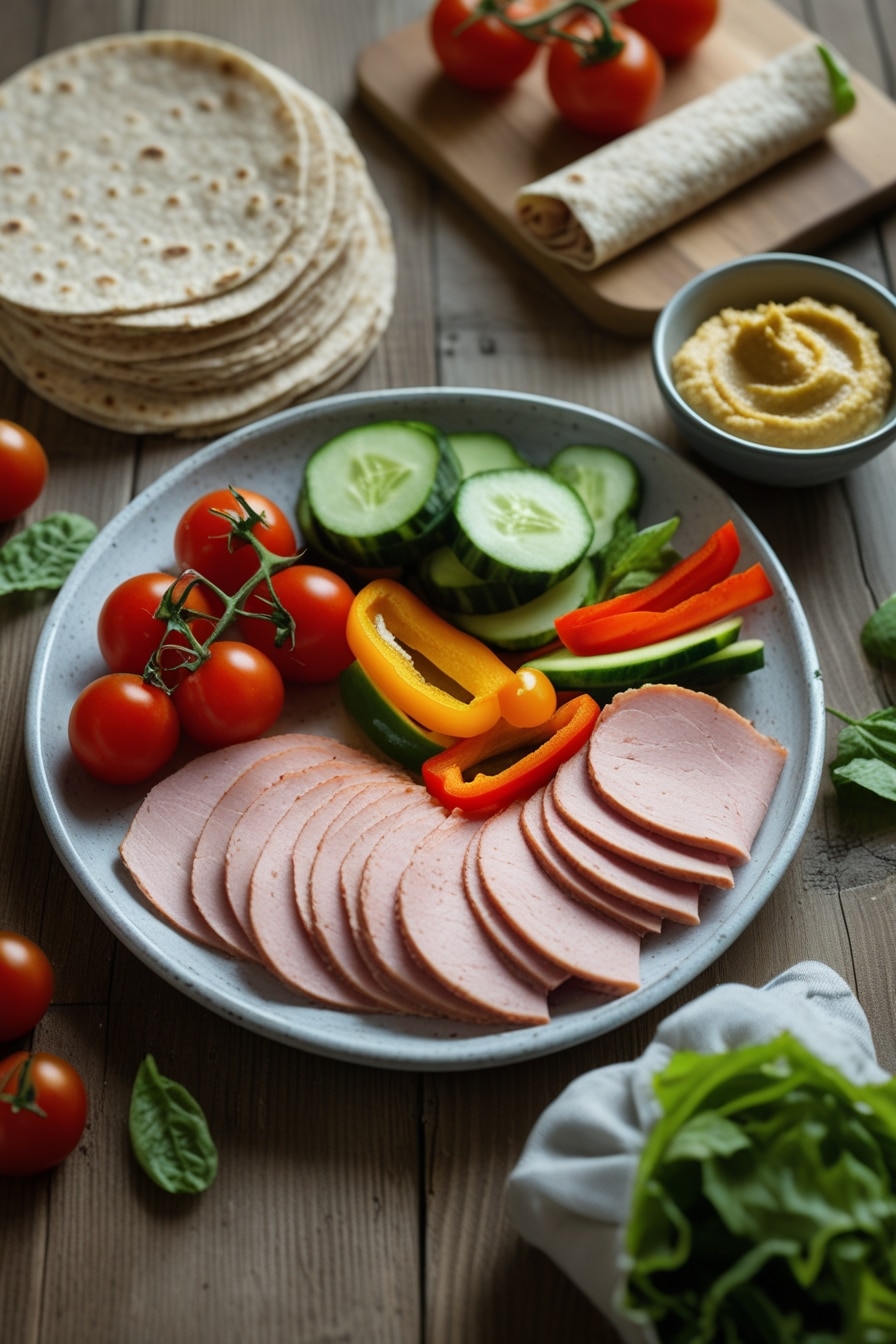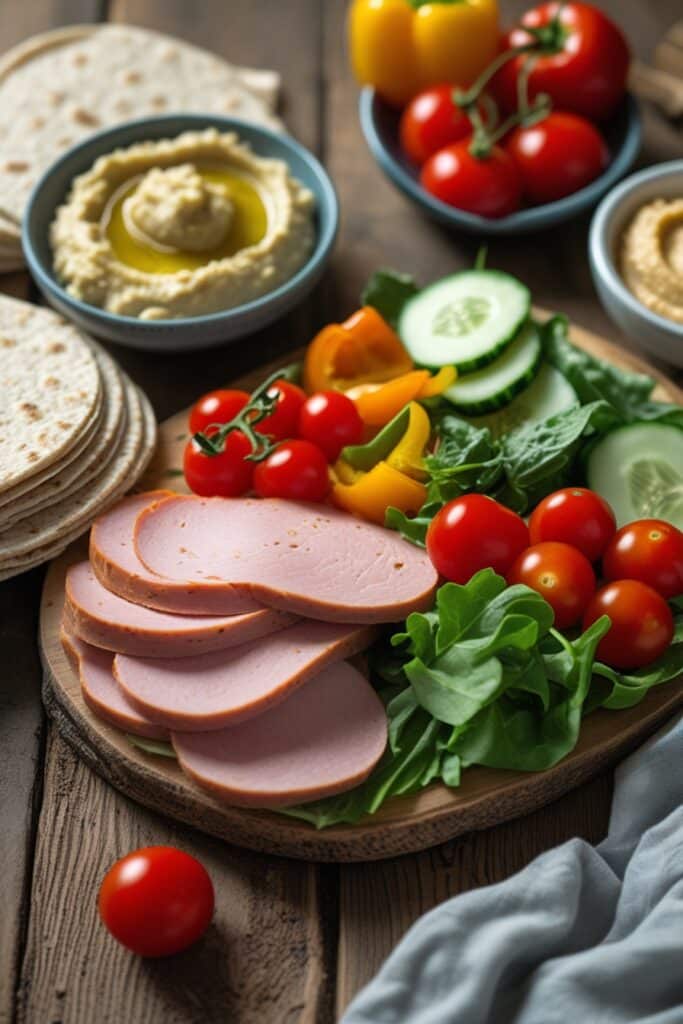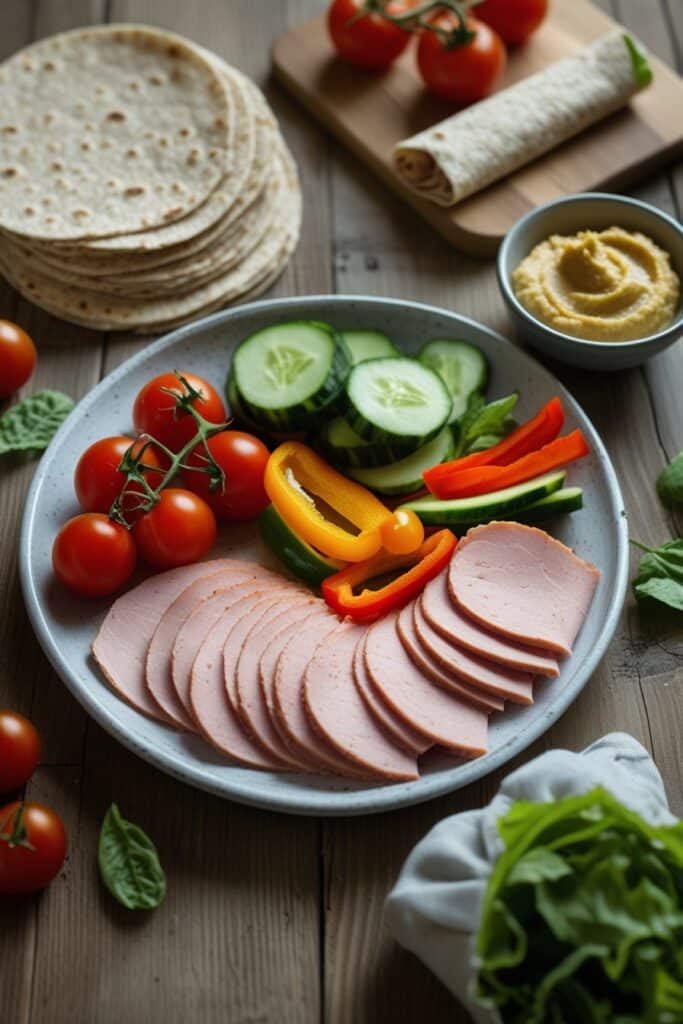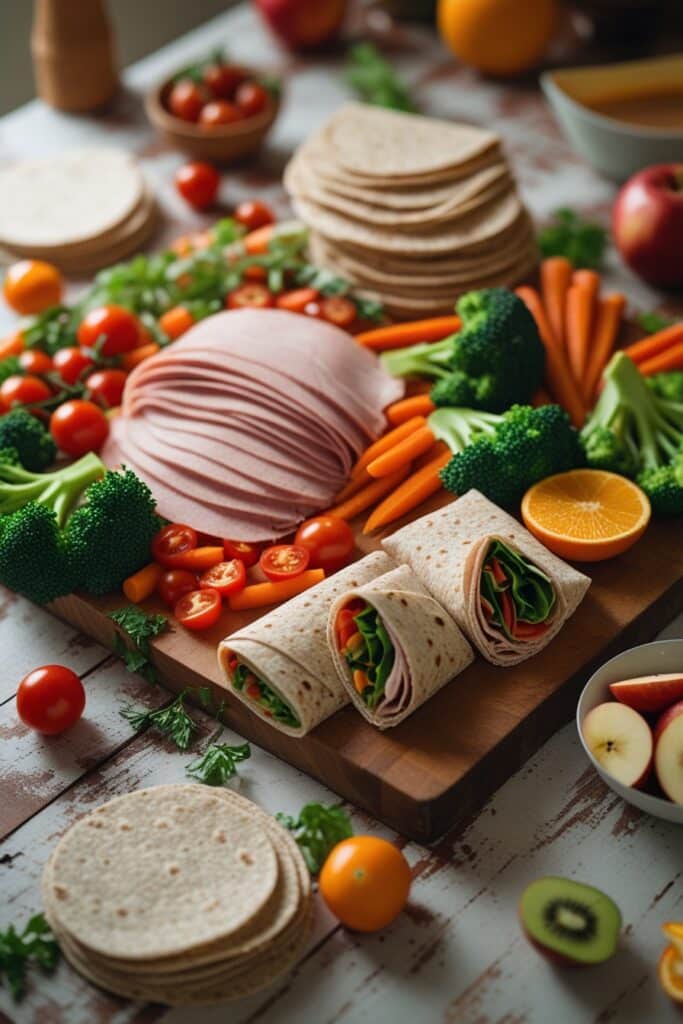Turkey Lunch Meat
When it comes to quick and easy meals, turkey lunch meat has become a fridge staple for families looking for healthy, protein-packed convenience. But is it as wholesome as it seems? In this article, we’ll explore everything you need to know about turkey lunch meat—from its nutritional pros and cons to what makes it pink and why it can get pricey. We’ll also look at what makes one brand better than another. Whether you’re making a classic sandwich or pairing it with high-protein sides, this guide breaks down the facts on turkey lunch meat to help you choose better.

Turkey Lunch Meat: Is It Healthy and Worth the Cost?
Ingredients
- Turkey lunch meat
- Whole grain tortilla wraps
- Hummus
- Shredded lettuce
- Sliced tomato
- Cucumber sticks
- Salt and pepper to taste
Instructions
- Lay the tortilla flat and spread hummus evenly.
- Layer turkey slices on top of the hummus.
- Add shredded lettuce, sliced tomato, and cucumber.
- Season with salt and pepper as desired.
- Roll the tortilla tightly into a wrap.
- Slice in half and serve immediately.
Notes
Nutrition
table of content
Table of Contents
Why Turkey Lunch Meat Stays Popular in American Kitchens
A Story from My Table: How Turkey Lunch Meat Became My Weeknight Lifesaver
Hi, I’m Elina—home cook, recipe developer, and mom behind Easy Meals Table. My love for cooking began in my grandmother’s kitchen, where simple ingredients became unforgettable meals. Today, I bring that same heart to quick, flavorful recipes designed for busy families.
For me, turkey lunch meat became more than just a sandwich filler the moment my youngest refused anything that took more than 10 minutes to prepare. Between after-school chaos and weekend sports, I needed a protein that was lean, fast, and versatile. That’s when turkey came into play. I’d pair it with protein bagels or roll it into a wrap with hummus and veggies—done in under 5 minutes. It’s now a go-to in my fridge, and I’ve explored every type from nitrate-free to smoked.
Turkey lunch meat is popular for a reason. It’s low in fat, high in protein, and incredibly convenient. It also works well beyond sandwiches. You can chop it into a salad, fold it into omelets, or pair it with the high protein cucumber salad for a no-fuss dinner.
Is Turkey a Healthy Lunch Meat?
The short answer? Generally, yes—when you choose wisely. Turkey lunch meat is lower in saturated fat than ham or salami and typically contains fewer calories. A 2-ounce serving can deliver 10–12 grams of protein with under 60 calories. It’s a solid choice if you’re watching your weight or trying to eat clean.
But not all deli turkey is created equal. Many options contain added sodium, preservatives, and nitrites—ingredients linked to health concerns when consumed in excess. If your package doesn’t say “no nitrates added” or “uncured,” you’re likely consuming chemical preservatives. Always read the label, and when possible, opt for minimally processed versions.
One tip I always give friends is to look for brands labeled “organic” or “no antibiotics ever.” These tend to use fewer additives. Brands like Applegate and Boar’s Head offer cleaner choices, though they may cost more.
To boost nutritional value, pair your turkey slices with nutrient-dense foods like avocado or the cottage cheese bagel for added protein and fiber.

What Makes the Best Turkey Lunch Meat?
Choosing the Best Turkey Lunch Meat: Not All Slices Are Equal
When you’re staring down the lunch meat aisle, “turkey” seems simple enough—until you’re faced with smoked, oven-roasted, honey-roasted, and low-sodium options from half a dozen brands. So, what’s the best turkey lunch meat?
The answer depends on your priorities: taste, texture, health, or cost. If you’re focused on health, look for labels that say “uncured,” “no added nitrites,” or “organic.” These versions usually avoid chemical preservatives and artificial flavoring. The fewer ingredients, the better. You should recognize every word on that ingredient list—turkey, water, salt, and spices should top it.
Taste-wise, oven-roasted tends to be the most universally loved. It has a mild, clean flavor that plays well in sandwiches or wraps. Smoked varieties offer bolder taste but often come with more sodium. Honey-roasted adds a slight sweetness that kids love, but that often comes with added sugars.
From a texture perspective, deli counter cuts from a whole turkey breast feel closer to real meat than the prepackaged, uniform slices. You’ll notice a richer bite and fewer slimy layers.
Personally, I often turn to turkey for make-ahead recipes like my chicken pesto bakes meal prep, simply swapping the chicken with thick slices of carved turkey lunch meat for a low-effort protein boost.
Why Is Turkey Lunch Meat Pink?
One question that comes up a lot, especially with kids (and some cautious adults), is this: why is turkey lunch meat pink?
The pink hue often causes concern, but it’s usually not a sign that the meat is undercooked or unsafe. In fact, the color comes from curing salts—specifically sodium nitrite—that preserve the meat and extend shelf life. These compounds interact with the turkey’s myoglobin (a protein found in muscle), stabilizing the pink shade even after cooking.
Uncured or nitrite-free versions may appear more beige or grayish, which is closer to what you’d expect from oven-roasted turkey at home. If you’re trying to avoid additives, go for those less-processed versions. They may not have that rosy deli sheen, but they’ll be closer to real home-cooked poultry.
That said, always check the expiration date and store your turkey meat correctly. Even though it’s preserved, lunch meat has a short shelf life once opened. I like pairing turkey with leftovers or using it in recipes like lemony hummus pasta for quick and wholesome meals before the pack goes bad.

Why Is Deli Turkey So Expensive?
The Real Reasons Behind the High Price
If you’ve ever picked up a pack of turkey lunch meat and winced at the price, you’re not alone. Many people wonder why sliced turkey seems more expensive than other proteins like whole chicken or ground beef. The truth is, a few factors push up the cost.
First, turkey lunch meat is a processed product. That means it’s not just sliced and packaged—it’s cooked, seasoned, sometimes smoked or cured, and carefully sealed to stay fresh. Each of those steps adds labor and materials, which increases the price.
Then there’s the packaging. Brands often use resealable plastic trays or vacuum seals to keep the slices fresh, and those cost more to produce than standard wrapping. You’re also paying for convenience—the ability to open your fridge and have a ready-to-eat protein saves time and effort, and that time-saving factor is priced in.
Finally, quality matters. Brands that use higher-grade turkey breast, avoid preservatives, or offer nitrate-free options tend to charge more because their ingredients and processes cost more. Organic turkey, for example, requires more ethical farming practices, which is reflected on the label.
If you’re trying to stretch your grocery budget, consider buying deli turkey from the counter in bulk—it’s often cheaper per pound than the prepackaged kind. Another tip: use turkey as a complement rather than the main event. Pairing it with something fresh like the pineapple cucumber salad can make a smaller portion feel like a full meal.
Is It Really Worth It?
When you compare turkey lunch meat to other deli meats like ham or bologna, it’s definitely on the pricier side. But it also delivers better nutritional value for many people.
Turkey is lean, lower in fat, and higher in protein per calorie. For those watching their weight or trying to cut processed fats, turkey is often the best choice. While bologna may be cheaper, it’s usually loaded with fillers, fat, and sodium.
For families who want to prioritize healthier eating during busy weeks, turkey lunch meat offers both nourishment and speed. That said, if you’re creative with planning, you can balance your meals and budget. For example, I often prep bulk proteins like this corned beef crock pot recipe on weekends, then use turkey as a quick backup option on hectic nights.
Turkey lunch meat may cost a bit more, but when you factor in its nutrition, convenience, and versatility, it’s often worth the price—especially when used wisely in balanced meals.

Making Turkey Lunch Meat Work for You
Easy, Healthy Ways to Use Turkey Lunch Meat (That Aren’t Boring)
Let’s be honest—turkey sandwiches can get old fast. But turkey lunch meat is more versatile than most people think. If you’re willing to think a little outside the sandwich, you can turn those slices into meals that feel fresh, satisfying, and exciting.
Start with wraps. Instead of bread, use lettuce leaves, low-carb tortillas, or even collard greens as your base. Fill them with turkey, hummus, shredded carrots, and a drizzle of vinaigrette. It’s quick, crisp, and lighter than your typical lunch.
You can also fold turkey into your breakfast. Dice it up and toss it into scrambled eggs, or roll slices into egg muffins for grab-and-go mornings. Another trick? Add strips of turkey to grain bowls or toss them over leafy greens with a homemade dressing. When paired with complex carbs and healthy fats, turkey creates a balanced, filling meal.
One of my favorite ways to use turkey lunch meat is as a snack board centerpiece. Roll up slices with cheese sticks, fruit, and a hard-boiled egg or two. It’s a quick and healthy alternative to processed snack packs—and the whole family can grab and go.
If you’re feeling a little creative, try swapping out chicken or beef in easy recipes. For instance, I’ve replaced the protein in my lemony hummus pasta with turkey for a lighter twist that still brings satisfying flavor. It’s a smart, low-effort hack on a busy night.
Keep It Fresh, Keep It Safe
Turkey lunch meat is convenient—but it’s also delicate. Once opened, it typically stays fresh for 3 to 5 days in the fridge. If you’re not going through it quickly, consider dividing the package and freezing half. It thaws well for most uses, especially in cooked dishes or wraps.
Pay attention to smell and texture. If your turkey feels slimy or smells off, don’t take the risk. Food safety matters—especially when you’re feeding kids or prepping meals ahead.
For variety and nutrition, mix turkey lunch meat with fiber-rich foods like whole grains, legumes, or fresh produce. Pairing it with something like the high-protein cucumber salad adds crunch, hydration, and extra staying power.
Ultimately, turkey lunch meat can be more than a sandwich saver. With a little imagination and thoughtful pairing, it becomes a go-to staple that fuels your week in fresh, creative ways.
Is turkey a healthy lunch meat?
Yes—when you choose high-quality versions. Turkey lunch meat is lean, low in fat, and rich in protein, making it one of the healthier deli meat options. Look for uncured, nitrate-free, and low-sodium labels for the cleanest choices. Avoid heavily processed brands with long ingredient lists and chemical preservatives.
What is the best turkey lunch meat?
The best turkey lunch meat depends on your preferences. For a healthy pick, opt for oven-roasted or organic varieties labeled “no antibiotics ever” or “uncured.” Brands like Applegate and Boar’s Head are often rated high for both quality and flavor. If freshness matters most, buy turkey sliced fresh at the deli counter from whole breast meat.
Why is turkey lunch meat pink?
That pink color comes from sodium nitrite, a curing agent used to preserve meat and enhance color. It interacts with natural proteins in turkey, locking in that rosy shade—even after cooking. If you’re avoiding additives, look for turkey labeled “no nitrates or nitrites added.” It may look more beige, but it’s closer to natural poultry.
Why is deli turkey so expensive?
Turkey lunch meat costs more because of its processing, packaging, and ingredient quality. Sliced, cooked, and sealed for freshness, it undergoes more steps than raw meat. Premium varieties that skip preservatives or use organic sources also add to the cost. For savings, buy in bulk at the deli counter or use turkey creatively in meals to stretch its value.
The Final Slice
Turkey lunch meat might seem like just another item on your grocery list, but it can play a powerful role in healthy, quick, and satisfying meals when chosen wisely. Whether you’re reaching for it because of its lean protein, convenience, or versatility, understanding the ingredients, labels, and storage tips helps you get the most out of every slice.
From balancing health with taste to stretching your budget and transforming tired lunches into creative meals, turkey lunch meat proves it’s more than just a sandwich filler. With thoughtful pairings and smart shopping, it can be one of the hardest-working staples in your fridge—keeping you fueled, satisfied, and stress-free.

2 thoughts on “Turkey Lunch Meat: Is It Healthy and Worth the Cost?”